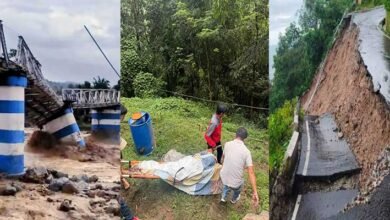Railways – The Engine of New Growth and Development in North-East India

 Railways – The Engine of New Growth and Development in North-East India .
Railways – The Engine of New Growth and Development in North-East India .
By- G Kishan Reddy, Union Minister of DoNER, Tourism, and Culture. In 1882, the first locomotive of the Dibru–Sadiya Railway connected the distant tea gardens with the Brahmaputra so that the commodity could eventually reach Kolkata. Over the decades since then, the Railways has helped reduce travel time from Dibrugarh to Kolkata from 15 days to 24 hours. However, even till 2014, the footprint of the Railways in the North East remained primarily restricted to current day Assam. In the last 8 years, stellar work has been done to ensure that this footprint expands across the North Eastern region and the sheer grit and perseverance in realising this dream needs to be told.
A New Dawn – Transforming North East
Rapid strides in surface transportation are key to the accelerated development of any region and Indian Railways is playing a pivotal role in the North East. Overcoming decades of neglect and under development, the Government has given an unprecedented impetus to connectivity in the region. Spearheading the efforts, Indian Railways, in the last 9 years has spent over Rs 50,000 Crores in the region on building new railway lines, bridges, tunnels etc. and has sanctioned new projects close to Rs 80,000 Crores.
This focus on Capital Expenditure has ensured that the Capital Connectivity Project that aims to connect all the North-East State Capitals is a reality now. As part of this, India is building the Jiribam – Imphal rail line which has the world’s tallest pier bridge at a height of 141 metres. To ensure timely completion of these projects, the Government of India has provided its complete support and resources. In comparison to the expenditure of Rs 2,122 Crores per year between 2009 and 2014, there has been a 370% increase in average annual budget allocation which now stands at Rs 9,970 Crores for the financial year 2022-23.
The topography of North East has always provided the toughest challenge in the region for any infrastructure development. However, a mix of strong political will and the use of state-of-the-art technologies has ensured that even the farthest corners of the region are being covered.121 new tunnels are currently being constructed and this include the 10.28 Kms long Tunnel Number 12 which is the second longest tunnel in the country.
Creating Jobs – Empowering the Youth
In an effort to promote local businesses and economy, the North-East Frontier Railway operated the first parcel cargo express train between Assam and Goa in 2022.Rani Gaidinliu is a much-revered spiritual leader of Nagaland and Manipur. It was a fitting tribute that the first ever freight train chugged into the Rani Gaidinliu Railway Station in Tamenglong district of Manipur.
Those who have visited the Northeast would vouch for the tremendous tourism potential that the region possesses. Across the Northeast the captivating scenery, the wildlife and the intangible heritage in the form of its culture and festivals has been a big draw. In an attempt to allow tourists to savour North East India’s breath-taking natural beauty, the North East Frontier Railways has introduced several state-of-the-art Vistadome coaches. This is expected to increase tourist footfalls which will further increase employment opportunities especially for women and disadvantaged communities such as tribals.
Railways has also been instrumental in creating employment opportunities for the youth in the region. In the last 3 financial years alone, Railways has engaged more than twenty thousand unskilled workers and generated vacancies for skilled work thereby contributing to the changing socio-economic landscape of the region.
Over a period of time, allowing local communities to find employment opportunities closer to their homes will arrest migration to other parts of the country protecting the region’s culture, identity and propagating it for future generations. A socially and financially empowered youth will be an asset to the region and to the nation.
NorthEast – Gateway to India’s Act East Policy
The 21st Century is often referred to as the Asian Century because of the rise of Asia as a global epicenter of economy, trade and power. India is the engine of this rise.
In 2014, India’s “Look East Policy” that focused on forging better economic relations with India’s Eastern neighbours was transformed into a more robust, result oriented and geo strategically important “Act East Policy”. In various foram Prime Minister Narendra Modi has mentioned that the Northeast Region would be the gateway to implementing a vibrant Act East Policy.
A glowing example of this policy is the landmark Agartala – Akhaura rail link being built between India and Bangladesh with a cost of more than Rs 1,100 Crores. It will not only establish historical rail links with our eastern neighbour but will also usher in a new era of growth and prosperity in the region. The Ministry for Development of North-Eastern Region (DoNER) and Ministry of External Affairs are co-funding this project. Similarly, the Imphal Railway line will be extended till Moreh and from there, it will connect to Myanmar Railways at Kalay, forming a Trans-Asian Railway.
Furthermore, identifying the geo-strategic importance of the region for national security, the government has decided to build a rail-road corridor which will connect Assam and Arunachal Pradesh. This will include building India’s first ever underwater rail tunnel under the BrahmaputraRiver. The rail – road connectivity being built, will ensure that there is connectivity right up to India’s north eastern borders and would give us the ability to act with speed and alacrity while responding to national security issues.
In the same vein, in 2017, the vitally strategic Dhola – Sadiya Bridge which connects Northern Assam and eastern Arunachal Pradesh was opened for traffic. It is the longest bridge built over water in India and can support the weight of India’s battle tanks and facilitate quick movement of troops to India’s north eastern borders.
The Indian Railways has employed modern, state-of-the-art technologies to expand its network in the region. In 2018, Asia’s second longest rail-cum-road bridge, the Bogibeel Bridge over the Brahmaputra River in Assam, was inaugurated. The bridge will cut down the travel distance between Assam and Arunachal by 80 % and will also provide logistical support to Indian Defence Forces. The bridge is designed to withstand earthquakes of magnitudes up to 7.0 on the Richter scale and can also be used for landing fighter jets.
Railways–Driving the Naya North East
Traditionally, the majestic Himalayas and the mighty Brahmaputra have influenced the life of nearly every citizen in North East. Now Railways has joined that list as it spreads its operations to different corners of the region.Growth and development in the region will contribute towards the goal of India becoming a US $5 trillion economy.
Prime Minister Modi had said that if India had to be prosperous, then development of North-East will need to be a priority and Railways is definitely one of the engines spurring this economic growth. Nine years later, the vision of the Prime Minister has been converted into a reality in the North-East region and Indian Railways is playing a pre-eminent role in this journey of transformation.









